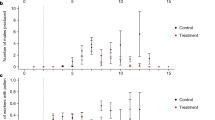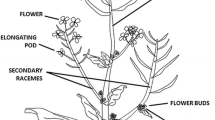Abstract
Pesticides targeted at pest species have often been demonstrated to have strong adverse effects on the survival of biological control agents in short-term laboratory bioassays; however, studies examining the influence of pesticides on the actual reproductive success of biological control agents in the field are rare. Because natural enemy reproduction is often directly tied to biological control success, effects of pesticides on reproduction are of central importance. Here we use a new technique to examine the influence of sulfur, a fungicide widely used in grape production, on the reproductive success of Anagrus erythroneurae (Hymenoptera: Mymaridae) and Anagrus daanei (Hymenoptera: Mymaridae), egg parasitoids of the grape leafhopper, Erythroneura elegantula (Homoptera: Cicadellidae). Sulfur has previously been shown to be highly toxic to Anagrus spp. in short-term laboratory and field bioassays, creating the expectation that sulfur should also reduce Anagrus reproductive success in the field. Surprisingly, in two studies, the first comparing the oviposition success of Anagrus collected live in paired sulfur-treated versus untreated vineyards and the second comparing the lifetime reproductive success of Anagrus collected at the end of their lives in unpaired sulfur-treated versus untreated vineyards, we found no effect of sulfur on parasitoid reproductive success. In this system, traditional short-term assays of laboratory toxicity do not appear to predict effects on parasitoid reproductive success, suggesting that demographic approaches to assessing the disruptive effects of pesticides may have an important role in designing IPM programs.



Similar content being viewed by others
References
Candolfi MP, Blümel S, Forster R, Bakker MF, Grimm C, Hassan SA, Heimbach U, Mead-Briggs MA, Reber B, Schmuck R, Vogt H (2000) Guidelines to evaluate side-effects of plant protection products to non-target arthropods. IOBC/WPRS, OILB/SROP, Gent, 158 pp
Corbett A, Rosenheim AJ (1996) Impact of a natural enemy overwintering refuge and its interaction with the surrounding landscape. Ecol Entomol 21:155–164
Costello MJ, Daane MK (1998) Arthropods. In: Ingels AC, Bugg LR, McGourty TG, Christensen PL (eds) Cover cropping in vineyards, a grower’s handbook, publication 3338. The Regents of the University of California, Division of Agriculture and Natural Resources, Oakland, California, pp 93–106
Croft BA (1990) Arthropod biological control agents and pesticides. John Wiley & Sons, New York
Cronin JT, Strong RD (1990) Biology of Anagrus delicatus (Hymenoptera: Mymaridae), an egg parasitoid of Prokelisia marginata (Homoptera: Delphacidae). Ann Entomol Soc Am 83:846–854
Delye C, Laigret F, CorioCostet FM (1997) New tools for studying epidemiology and resistance of grape powdery mildew to DMI fungicides. Pestic Sci 51:309–314
Doutt RL, Nakata J (1965) Overwintering refuge of Anagrus epos (Hymenoptera: Mymaridae). J Econ Entomol 58:586
Doutt RL, Nakata J (1973) The Rubus leafhopper and its egg parasitoid: an endemic biotic system useful in grape-pest management. Environ Entomol 2:381–386
English-Loeb G, Rhainds M, Martinson TE, Ugine T (2003) Influence of flowering cover crops on Anagrus parasitoids (Hymenoptera: Mymaridae) and Erythroneura leafhoppers (Homoptera: Cicadellidae) in New York vineyards. Agric For Entomol 5:173–181
Flaherty DL, Wilson LT, Stern VM, Kido H (1985) Biological control in San Joaquin Valley vineyards. In: Herzog DC, Hoy AM (eds) Biological control of agricultural IPM systems. Wiley, New York, pp 501–520
Flaherty DL, Christensen PL, Lanini WT, Marois JJ, Phillips PA, Wilson LT (1992) Grape pest management, 2nd edn, publication 3343. The Regents of the University of California, Division of Agriculture and Natural Resources, Oakland, California, pp 140–152
Hanna R, Zalom FG, Wilson LT, Leavitt GM (1997) Sulfur can suppress mite predators in vineyards. Calif Agr 51:19–21
Heimpel GE, Rosenheim JA, Kattari D (1997) Adult feeding and lifetime reproductive success in the parasitoid Aphytis melinus. Entomol Exp Appl 83:305–315
James DG, Price TS, Wright LC, Perez J (2002) Abundance and phenology of mites, leafhoppers, and thrips on pesticide-treated and untreated wine grapes in southcentral Washington. J Agric Urban Entomol 19:45–54
Jepsen SJ, Rosenheim JA, Bench ME (2007) The effect of sulfur on biological control of the grape leafhopper, Erythroneura elegantula, by the egg parasitoid Anagrus erythronuerae. BioControl, DOI 10.1007/s10526-006-9058-9
Jervis MA, Heimpel GE, Ferns PN, Harvey JA, Kidd NAC (2001) Life-history strategies in parasitoid wasps: a comparative analysis of ‘ovigeny’. J Anim Ecol 70:442–458
Jervis MA, Kidd NAC, Fitton MG, Huddleston T, Dawah HA (1993) Flower-visiting by hymenopteran parasitoids. J Nat Hist 27:67–105
Kido H., Flaherty DL, Bosch D, Valero KA (1984) French prune trees as overwintering sites for the grape leafhopper egg parasite. Am J Enol Vitic 35:156–160
Martinson T, Williams L III, English Loeb G (2001) Compatibility of chemical disease and insect management practices used in New York vineyards with biological control by Anagrus spp. (Hymenoptera: Mymaridae), parasitoids of Erythroneura Leafhoppers. Biol Control 22:227–234
Murphy BC, Rosenheim AJ, Granett J (1996) Habitat diversification for improving biological control: abundance of Anagrus epos (Hymenoptera: Mymaridae) in grape vineyards. Environ Entomol 25:495–504
Murphy BC, Rosenheim JA, Dowell RV, Granett J (1998) Testing a habitat diversification tactic for improving biological control: parasitism of the western grape leafhopper, Erythroneura elegantula (Homoptera: Cicadellidae). Entomol Exp Appl 87:225–235
Nicholls CI, Parrella M, Altieri MA (2001) The effects of a vegetational corridor on the abundance and dispersal of insect biodiversity within a northern California organic vineyard. Landsc Ecol 16:133–146
Prischmann DA, James DG, Wright LC, Teneyck RD, Snyder WE (2005) Effects of chlorpyrifos and sulfur on spider mites (Acari: Tetranychidae) and their natural enemies. Biol Control 33:324–334
Rosenheim JA (1998) Higher-order predators and the regulation of insect herbivore populations. Annu Rev Entomol 43:421–447
Rosenheim JA, Heimpel GE, Mangel MA (2000) Egg maturation, egg resorption and the costliness of transient egg limitation in insects. Proc R Soc B Biol Sci 267:1565–1573
SAS Institute (2000) JMP user’s manual, version 4.0.2. SAS Institute, Cary, NC
Settle WH, Wilson TL (1990) Invasion by the variegated leafhopper and biotic interactions: parasitism, competition, and apparent competition. Ecology 71:1461–1470
Stark JD, Banks JE (2003) Population-level effects of pesticides and other toxicants on arthropods. Annu Rev Entomol 48:505–519
Suh CPC, Orr DB, Van Duyn JW, Borchert MD (2002) Influence of cotton microhabitat on temperature and survival of Trichogramma (Hymenoptera: Trichogrammatidae) within cardboard capsules. Environ Entomol 31:361–366
Teodoro AV, Fadini MAM, Lemos WP, Guedos RNC, Pallini A (2005) Lethal and sub-lethal selectivity of fenbutatin oxide and sulfur to the predator Iphiseiodes zuluagai (Acari: Phytoseiidae) and its prey, Oligonychus ilicis (Acari: Tetranychidae), in Brazilian coffee plantations. Exp Appl Acarol 36:61–70
Theiling KM, Croft BA (1988) Pesticide side-effects on arthropod natural enemies: a database summary. Agric Ecosyst Environ 21:191–218
Triapitsyn SV (1998) Anagrus (Hymenoptera: Mymaridae) egg parasitoids of Erythroneura spp. and other leafhoppers (Homoptera: Cicadellidae) in North American vineyards and orchards: a taxonomic review. T Am Entomol Soc 124:77–112
U.S. Environmental Protection Agency (1991) Reregistration eligibility document facts: sulfur. Pesticides and Toxic Substances, Washington, DC
van Emden HF, Peakall DB (1996) Beyond silent spring integrated pest management and chemical safety. Chapman & Hall, London
Wäckers FL (2004) Assessing the suitability of flowering herbs as parasitoid food sources: flower attractiveness and nectar accessibility. Biol Control 29:307–314
Williams MD, Gill G (1996) Evaluation of pesticides for side effects on the leafhopper parasitoid Anagrus atomus with particular reference to protected crops. Test Agrochem Cultivar 17:98–99
Acknowledgments
We thank the following people for their contributions to this research: Jill Hodgen, Matt Judd, Katherine Chmiel, Nicholas Coustour, Mike Kabler and Erin Duffey. We acknowledge the members of the Rosenheim lab for their helpful comments: Andy Zink, Ken Spence, Maggie Sherriffs, Frances Sheller, Jon Haloin, and Monica Chau. Jeff Granett and Rick Karban provided additional advice in the writing of this manuscript. Both Tom Kominek (UC Davis, Plant Pathology) and Dick Hoenisch (UC Davis, Viticulture and Enology) were very helpful in facilitating the field-components of this study. This work would not have been possible without the help of numerous vineyard owners and managers who graciously allowed us to sample on their property, including: Rand Schaal, Paul and Sally Kimsey, Mark Rubald (Village Homes), Paul Wilms, Sam Turner (Blair vineyard), Ruben Ybarra (Cypress Ranch), Raphael Jimenez (Haffner), John Arnold (Liberty), and Gary Morisoli (Niebaum-Coppola).
Author information
Authors and Affiliations
Corresponding author
Rights and permissions
About this article
Cite this article
Jepsen, S.J., Rosenheim, J.A. & Matthews, C.E. The impact of sulfur on the reproductive success of Anagrus spp. parasitoids in the field. BioControl 52, 599–612 (2007). https://doi.org/10.1007/s10526-006-9056-y
Received:
Accepted:
Published:
Issue Date:
DOI: https://doi.org/10.1007/s10526-006-9056-y




